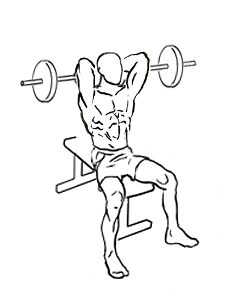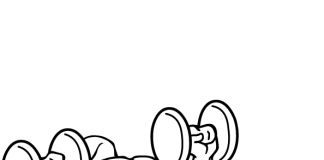Last Updated on September 24, 2014
The Seated Overhead Triceps Extension with barbell is an advanced exercise that emphasizes isolating the triceps, making it a go-to movement for bodybuilders, strength trainers, and fitness enthusiasts alike. This exercise targets the triceps’ long head, providing that desirable horseshoe shape and boosting arm strength for other pressing movements.
Here’s everything you need to know to master the seated overhead triceps extension with a barbell, including a detailed step-by-step guide, benefits, common mistakes to avoid, and tips for getting the most out of your workout.
Benefits of Seated Overhead Triceps Extension
- Focuses on the Triceps Long Head: This exercise primarily isolates the long head of the triceps, which is often hard to target but essential for full tricep development.
- Improves Arm Strength for Other Exercises: Stronger triceps mean better performance in compound exercises like bench presses, shoulder presses, and push-ups.
- Enhances Arm Size and Definition: Triceps account for a large portion of upper arm mass. By building them up, you’re well on your way to bigger, more defined arms.
- Functional Upper Body Strength: Triceps are critical for pushing movements, not just in the gym but also in everyday activities, like pushing doors open or lifting objects overhead.
Proper Technique for Seated Overhead Triceps Extension with Barbell
Step 1: Setting Up
- Choose a short straight-back chair or an adjustable bench set in an upright position. Avoid chairs that recline, as this will hinder your stability.
- Sit with your feet shoulder-width apart, flat on the floor, and maintain a straight back.
- Grasp the barbell, EZ bar, or curl bar with an overhand grip, keeping your hands about six inches apart.
Step 2: Starting Position
- Lift the barbell overhead until your arms are fully extended but avoid locking your elbows. Your palms should face upward, and the bar should be directly above your head.
Step 3: Lowering the Bar
- Slowly bend your elbows, allowing the bar to move in an arc toward the floor behind your head.
- Keep your elbows stationary—don’t let them flare out. This control will ensure maximum tension on the triceps.
- Lower the bar until you feel a stretch in your triceps, which should be just below a 90-degree angle at the elbow.
Step 4: Returning to Starting Position
- Push through your triceps to extend your arms back to the starting position.
- Keep the movement slow and controlled, avoiding any jerking or using momentum to lift the weight.
Step 5: Repeat
- Aim for 3 to 4 sets of 8 to 12 repetitions, adjusting the weight based on your fitness level. Proper form is crucial, so start with a manageable weight and increase as you gain strength.
Tips to Maximize Triceps Activation
- Use a Slightly Narrow Grip: This keeps tension on the triceps and minimizes shoulder involvement.
- Slow, Controlled Movements: Don’t rush through the reps. A slow, controlled descent and ascent keep the muscles under tension longer.
- Avoid Full Elbow Lockout: Keep a slight bend in the elbows at the top of each rep to maintain tension on the triceps.
Variations of Seated Overhead Triceps Extension
1. Single-Arm Overhead Triceps Extension
- This variation is performed with a single dumbbell or kettlebell, allowing you to focus on each arm individually, which can help correct muscle imbalances.
2. Standing Overhead Triceps Extension
- Performing the overhead extension from a standing position engages the core and improves stability.
3. Cable Overhead Triceps Extension
- Using a cable machine for overhead extensions keeps constant tension on the triceps throughout the movement, beneficial for improving muscle endurance and strength.
Common Mistakes to Avoid
- Flaring Elbows: Letting the elbows drift outward reduces tension on the triceps and may strain the shoulders.
- Using Too Much Weight: Start light to focus on form. Using too heavy a weight can lead to sloppy form, limiting effectiveness and increasing injury risk.
- Arching the Lower Back: It’s common for beginners to arch the lower back to compensate for heavy weight. Keep your core tight and back neutral throughout the movement.
- Speeding Through Reps: Quick reps don’t allow the triceps to be fully engaged. Aim for a slow descent and powerful but controlled lift.
How to Incorporate This Exercise into Your Routine
- Upper Body or Arm Day: Include it as part of your arm or upper body workout routine to give the triceps a dedicated burn.
- Superset with Other Tricep Exercises: Pair with close-grip bench presses or dips for a full triceps workout.
- Endurance Training: Use lighter weights with higher reps for endurance or incorporate drop sets to fatigue the muscles.
Frequently Asked Questions
1. What’s the best weight to start with for this exercise?
- Beginners should start with a lightweight, like a 10-15 lb barbell, focusing on form. Increase gradually as your triceps strengthen.
2. Should I do this exercise seated or standing?
- While both seated and standing variations are effective, the seated position stabilizes the core, allowing you to focus more on isolating the triceps.
3. How many times a week should I train triceps?
- 2 to 3 times per week is ideal for most, allowing the muscles time to recover.
Muscle Anatomy and Mechanics: Why This Exercise Works
The triceps brachii muscle, located on the back of your upper arm, is responsible for extending the elbow. The long head of the triceps is uniquely activated in overhead movements, unlike the other heads, which are primarily worked in pressing exercises. The overhead position allows for a fuller range of motion, maximizing triceps activation, especially in the long head.
By training all three heads of the triceps, you’ll achieve stronger, well-rounded arms that also support upper-body movements.
Adjustments for Different Fitness Levels
Beginners
- Begin with an EZ bar, which is lighter than a standard barbell and easier on the wrists.
- Focus on using a manageable weight and practicing the motion without any additional resistance.
Intermediate
- Increase the weight slightly as you become comfortable with the movement. Start incorporating more controlled reps or consider supersets.
Advanced
- For more experienced lifters, the Seated Overhead Triceps Extension can be made more challenging by using a heavier barbell or incorporating resistance bands for extra tension.
- Use slower eccentric (lowering) phases to maximize time under tension for advanced muscle growth.
Safety Precautions
- Choose the Right Weight: Using a weight that’s too heavy can strain your shoulders and elbows.
- Use a Spotter if Possible: The overhead position makes this movement tricky to control if you’re fatigued.
- Warm Up Properly: Do a few sets of lighter tricep exercises or stretches to prepare the elbows and shoulders.
Wrapping Up: Building Stronger, Defined Triceps
The Seated Overhead Triceps Extension with a barbell is a fantastic exercise for anyone serious about building strong, sculpted arms. This movement isolates the triceps, challenges stability, and increases strength, making it perfect for improving upper body power.








